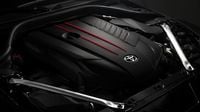The electric vehicle revolution is shifting into high gear, and nowhere is that more evident than at this year’s Japan Mobility Show. Two of Japan’s automotive giants—Honda and Toyota—are taking strikingly different roads toward the future of performance and electrification, offering a glimpse into the evolving philosophies that will shape the next generation of cars.
Honda’s latest unveiling, the ‘Honda 0 Saloon,’ marks a bold step into the electric age. First shown at the 2024 CES show and now making a prominent appearance at the Japan Mobility Show 2025, the 0 Saloon is the flagship of Honda’s newly announced ‘0 Series’ of electric vehicles (EVs). With a global launch planned for 2026, Honda is betting big on this model to redefine its image and set the pace for its EV ambitions.
According to reporting from 2025-10-30, the Honda 0 Saloon is more than just a concept car. It’s a vision for what the brand believes an electric sedan should be: sleek, low-profile, and technologically advanced. The car sits low to the ground, boasting a sporty silhouette that manages to look both futuristic and approachable. Its body is smooth and striking—perhaps less curvaceous than the recently unveiled Prelude, but every bit as eye-catching. Unique lighting elements and the possible use of cameras in place of traditional side mirrors (a trick borrowed from some Korean and German automakers) add to its forward-thinking appeal.
Step inside, and the 0 Saloon continues to impress. The cabin is designed with space and comfort in mind, featuring a large, open interior that feels more like a lounge than a traditional car. The dashboard is dominated by expansive displays stretching across its length, and the steering wheel is replaced by a ‘steering yolk’—a nod to both innovation and the influence of high-tech competitors. It’s clear Honda wants this car to feel like a leap forward, not just an incremental update.
But the real star of the show is what lies beneath the surface. The 0 Saloon is built on a thin, lightweight, dedicated EV platform, which Honda says improves aerodynamics and opens up new possibilities for design flexibility. This approach is meant to give Honda’s electric models a distinctive edge—both in terms of efficiency and aesthetics. The car also features the ASIMO OS, an advanced operating system designed to personalize the driving experience and enable Level 3 automated driving. That means, at least in certain conditions, the car can handle itself without constant driver supervision—a tantalizing step toward the autonomous future.
Honda’s strategy is clear: embrace the opportunities of electrification, push the boundaries of design, and deliver a product that feels genuinely new. The company’s focus on lightweight construction and advanced tech signals a serious commitment to making EVs not just practical, but desirable.
Yet, just across the show floor, Toyota is charting a different course—one that’s equally bold, but in many ways the opposite of Honda’s. While Toyota has long been a leader in hybrid technology, especially in the realm of passenger cars, its approach to sporty electrification is notably cautious. That perspective was underscored at the Tokyo Mobility Show on October 30, 2025, when Toyota Powertrain Company President Takashi Uehara made headlines with his candid remarks.
Speaking to Road & Track, Uehara was unequivocal: “Only for the performance vehicles, maybe we don’t need the hybrid system. Because no electrification is the best for performance cars on the circuit.” He elaborated that, despite Toyota’s deep experience with hybrid performance systems—citing the company’s work with Formula 1’s KERS system and its ongoing participation in the World Endurance Championship (WEC) in Europe—he doesn’t see a need to expand hybrid technology to the brand’s consumer performance cars. For Uehara, the issue is simple: “Just for the feeling, just for the lap time, the weight of the battery and motor is not so good for the performance. So just for the sport cars, for the passenger vehicles, I prefer engines just with manual transmissions. No electrification is best.”
This isn’t just a matter of engineering, but of philosophy. Toyota’s stance runs counter to a growing industry trend, as automakers like Ferrari, BMW, and Chevrolet increasingly turn to battery technology to boost their performance models. These companies use electric motors to fill torque gaps, improve acceleration, and meet ever-tightening emissions standards. But Toyota, at least for now, remains committed to the visceral experience of traditional gasoline-powered sports cars. As Uehara’s comments suggest, the company believes that the added weight of batteries and electric motors undermines the purity and agility that enthusiasts crave.
Of course, Toyota’s position isn’t entirely rigid. The company has dabbled with hybrid sports cars before. Back in 2017, it showcased the GR HV Sports Concept—a gas-electric hybrid with rear-wheel drive and an innovative automatic gearbox that could mimic an H-pattern manual shifter. The concept, however, never made it to production. Meanwhile, the Lexus LC 500h, a hybrid-powered grand tourer, did reach the market and has earned praise for its blend of performance and efficiency. There are also rumors swirling about Toyota’s upcoming high-end performance car, which may incorporate hybrid technology after all. So, while the anti-hybrid sports car stance is strong, it’s not absolute.
That nuance was echoed earlier this year by Toyota Chairman Akio Toyoda. In comments to Automotive News, Toyoda acknowledged that “there will always be people inside Toyota passionate about developing electric sports cars.” But for him personally, “my definition of a sports car is something with the smell of gasoline and a noisy engine.” It’s a perspective that values tradition and sensory experience, even as the industry moves inexorably toward electrification.
For car enthusiasts and consumers alike, these divergent strategies raise some interesting questions. Will Honda’s embrace of advanced EV tech and bold design win over drivers looking for something fresh and futuristic? Or will Toyota’s commitment to old-school performance—and its skepticism about the trade-offs of electrification—continue to resonate with purists who crave the roar of an engine and the tactile feel of a manual gearbox?
What’s clear is that the Japanese auto industry isn’t marching in lockstep when it comes to the future of performance vehicles. Honda and Toyota, two titans with storied histories and global reach, are each betting on different visions of what drivers will want in the years ahead. As the 2026 launch of the Honda 0 Saloon approaches, and as Toyota continues to refine its approach to hybrid and electric performance, the world will be watching closely to see which philosophy captures the imagination—and the loyalty—of the next generation.
For now, the Japan Mobility Show offers a snapshot of an industry at a crossroads, with innovation and tradition locked in a fascinating, high-stakes race. The finish line? That’s still up for grabs.




